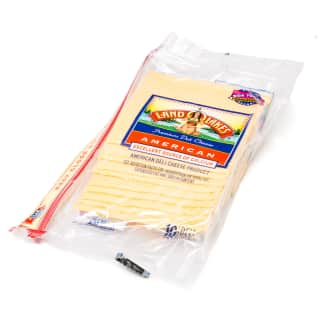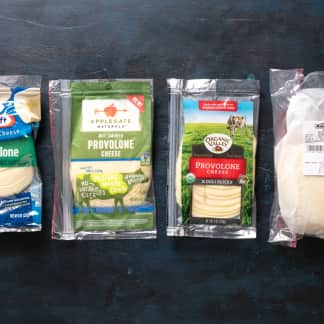Reviews You Can Trust.
See Why.
American Cheese
Hate to love it or love to hate it? We slice through the stigma surrounding American cheese.
Editor&aposs Note:UpdateApril, 2017
Top Pick

WinnerBoar’s Head American Cheese
Sign up for the Well-Equipped Cook newsletter
Shop smarter with our ATK Reviews team's expert guides and recommendations.
What You Need to Know
American cheese is polarizing. A good American cheese is mild, but not bland, and melts like a dream in grilled cheese sandwiches and atop burgers. But in this age of slow food, plastic-wrapped cheese slices have become a symbol of hyperprocessing. Could we find a product that we actually liked?
To find out, we asked 21 America’s Test Kitchen staffers to sample seven nationally available American cheeses plain and in grilled cheese sandwiches.
Tasters didn’t like bland cheeses, so we examined salt levels, but we saw no clear trend. Instead we noticed a different pattern: The shorter the ingredient list, the better-tasting the cheese. Our top product listed just five ingredients—cheese, water, cream, sodium phosphates, and salt—and was praised by tasters for its cheddar-like sharpness, while the bland bottom-ranked cheeses contained up to 20 ingredients, many of them processed dairy derivatives like whey or milk protein.
We reached out to experts to figure out what impact these ingredients might have on cheese flavor. They told us that some manufacturers cut costs by using less actual cheese in their products and more comparatively cheap dairy ingredients like milk, whey, or milk protein concentrate. While these dairy products contain many of the proteins found in cheese, they lack the bacterial cultures that contribute sharp, nutty flavors. This explained why products with whey or milk protein concentrate tasted bland and boring, while top-ranked brands were complex and tangy.
To confirm that our top-ranked products contain more actual cheese, we sent the products to an independent lab for analysis. Since cheese is higher in fat and protein than other dairy products, products with more natural cheese will also usually have significantly more fat and protein than products that use whey or milk concentrates. This held true in our lab results—lower-ranked cheeses that use alternate dairy products contained as little as 8 percent fat and 14 percent protein, while our recommended cheeses contained more than 27 percent fat and 19 percent protein.
Lab results helped explain textural differences. Experts told us that replacing natural cheese with other dairy adds moisture to the final product. Our bottom-ranked cheeses did indeed have higher moisture percentages (up to 51 percent, compared with 40 percent moisture in top products), and many of these cheeses were watery and wet when melted. Some products attempted to counteract excessive moisture by adding gelatin or other thickeners, but tasters thought that these additives made for grilled cheese that was too gummy and stiff.
So how can you tell if you’re getting a product with more real cheese? Turns out, the answer is right on the front of the package. In 1950, the U.S. Food and Drug Administration (FDA) ruled that American cheese must be labeled in clear, capital letters on its packaging as “process cheese,” “cheese food,” or “cheese product.” What do they mean?
We didn’t see any brands using the term “cheese food,” only “process cheese” and “cheese product.” In order for a product to be labeled as “process cheese,” it has to meet strict FDA specifications (which parallel our tasters’ preferences): Products must have less than 43 percent moisture and contain no whey, milk protein concentrates, or thickeners. By contrast, the FDA does not have standards for the term “cheese product,” and manufacturers are free to make these products as they desire. Our top two American cheeses were the only products in the lineup labeled as “process cheese.” Unfortunately, quality also added to the price. Since real cheese is a more expensive ingredient than fillers, our top products cost two to three times as much as lower-rated entries.
In the end, our winner led the pack with its complex sharpness and nutty, rich flavor. This process cheese costs almost twice as much as cheese products, but tasters thought that the extra money was worth it for perfectly “creamy” cheese that was “familiar,” yet “sophisticated.”
Everything We Tested
Highly Recommended

WinnerBoar’s Head American Cheese
Recommended

Kraft Deli Deluxe American Cheese

Land O’Lakes Deli American Cheese Product
Recommended with reservations

Kraft Singles
Not Recommended

Borden American Cheese Singles

Crystal Farms American Cheese

Velveeta Slices
*All products reviewed by America’s Test Kitchen are independently chosen, researched, and reviewed by our editors. We buy products for testing at retail locations and do not accept unsolicited samples for testing. We list suggested sources for recommended products as a convenience to our readers but do not endorse specific retailers. When you choose to purchase our editorial recommendations from the links we provide, we may earn an affiliate commission. Prices are subject to change.
Reviews You Can Trust
The mission of America’s Test Kitchen Reviews is to find the best equipment and ingredients for the home cook through rigorous, hands-on testing. Have a question or suggestion? Send us an email at atkreviews@americastestkitchen.com. We appreciate your feedback!
Reviews You Can Trust.
See Why.



